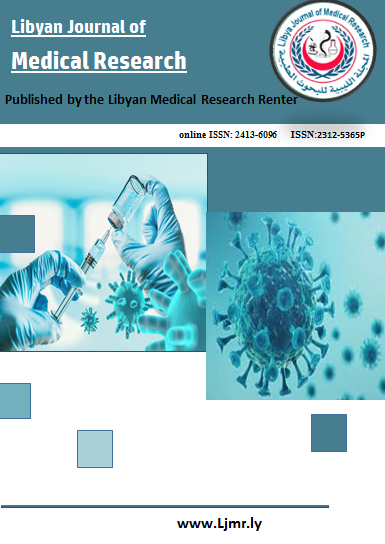Hospital based study of prevalence thyroid Disorders between pregnant and non-pregnant Saudi women in Aljouf, Saudi Arabia
DOI:
https://doi.org/10.54361/LJMR.19.1.21Keywords:
Hospital based, Prevalence, thyroid disorder, pregnant women, non-pregnant womenAbstract
Background: Since thyroid hormones are essential to the fetus's general growth, their effect on the outcomes of pregnancy must be carefully taken into account.
Objective: The goal of this research is to compare the prevalence of thyroid disorders in Saudi women who are pregnant and those who are not, using a hospital-based approach.
Methods: This hospital-based observational cross-sectional study conducted at Obstetrics department of Maternity and Children hospital (MCH) over a period of January 2022 to February 2023. A total of 150 women participated among 75 pregnant women and 75 non-pregnant reproductive age women respectively. Thyroid function test were obtained from them.
Results: Of the subjects, 46.8% had thyroid disorders, with 35.4% having hypothyroidism and 11.4% having hyperthyroidism. The prevalence of thyroid disorder was substantially greater in pregnant women (73.3.0%) compared to non-pregnant women (20.0%; P <0.001). The odds ratio of hypothyroid disorders was substantially greater in pregnant women than in non-pregnant women (OR 3.85; P <0.001). Thyroid disease risks in pregnant women were considerably greater than in non-pregnant women, even following adjustment for the age biases. effect (p = 0.001).
Conclusion: Women who are pregnant are more likely than those who are not to have thyroid conditions, particularly hypothyroidism.
Downloads
References
1. S. O. LeBeau and S. J. Mandel, “Thyroid disorders during pregnancy,” Endocrinology and Metabolism Clinics of North America. 2006;35(1): 117–136.
2. B. Vaidya, S. Anthony, M. Bilous et al., “Detection of thyroid dysfunction in early pregnancy: universal screening or targeted high-risk case finding?” The Journal of Clinical Endocrinology and Metabolism. 2007; 92 (1):203–207.
3. J. Horacek, S. Spitalnikova, B. Dlabalova et al., “Universal screening detects two-times more thyroid disorders in early pregnancy than targeted high-risk case finding,” European Journal of Endocrinology. 2010; 163 (4): 645–650.
4. Bandela PV, Havilah P, Hindumathi M, Prasad KD. Antenatal thyroid dysfunction in Rayalaseema region: a preliminary cross-sectional study based on circulating serum thyrotropin levels. Int J Appl Biol Pharm Technol. 2013; 4: 74-8.
5. J. G. Hollowell, N. W. Staehling, W. D. Flanders et al., “Serum TSH, T4, and thyroid antibodies in the United States population (1988 to 1994): National Health and Nutrition Examination Survey (NHANES III). The Journal of Clinical Endocrinology and Metabolism.2002; 87( 2) :489–499.
6. G. N. Burrow, “Thyroid function and hyperfunction during gestation,” Endocrine Reviews. 1993;14 (2) :194–202, 1993.
7. Alexander EK, Pearce EN, Brent GA et al. 2017 Guidelines of the American Thyroid Association for the diagnosis and management of thyroid disease during pregnancy and the postpartum. Thyroid. 2017; 27: 315–89.
8. Khakurel G, Karki C, Chalise S. Prevalence of thyroid disorder in pregnant women visiting a tertiary care teaching hospital: a descriptive cross-sectional study. J Nepal Med Assoc 2021; 59: 51-4. DOI: 10.31729/jnma.5529.
9. Gupta P, Jain M, Verma V, Gupta NK. The study of prevalence and pattern of thyroid disorder in pregnant women: a prospective study. Cureus. 2021; 13: e16457. DOI: 10.7759/cureus.16457
10. Sharma SK, Gurung G, Katuwal N et al. Prevalence of thyroid dysfunction during first trimester of pregnancy: A descriptive cross-sectional study. Reproductive Female Child Health. 2023; 2: 203-7.
11. Nambiar V, Jagtap VS, Sarathi V, Lila AR, Kamalanathan S, Bandgar TR, et al. Prevalence and impact of thyroid disorders on maternal outcome in Asian Indian pregnant women. J Thyroid Res. 2011; 2011: 4290- 4297.
12. Weiwei Wang, et al. The prevalence of thyroid disorders during early pregnancy in China: The benefits of universal screening in the first trimester of pregnancy. European Journal of Endocrinology. 2011; 164: 263-268.
13. Taghavi M, Saghafi N, Shirin S. Outcome of Thyroid Dysfunction in Pregnancy in Mashhad, Iran. Int J Endocrinol Metab. 2009; 2: 82-85.
14. Ajmani Sangita Nangia, et al. Prevalence of overt and subclinical thyroid dysfunction among pregnant women and its effect on maternal and fetal outcome. The Journal of Obstetrics and Gynaecology of India. 2014; 64(2): 105 110.
15. Rajesh Rajput, et al. Prevalence of thyroid dysfunction among women during the first trimester of pregnancy at a tertiary care hospital in Haryana. Ind J Endocrinol Metab. 2015; 19(3): 416 - 419.
16. Neale DM, Cootauco AC, Burrow G. Thyroid disease in pregnancy. Clin Perinatol. 2007;34(4):543-557.
17. Haddow, J. E. et al. Maternal thyroid deficiency and pregnancy complications: implications for population screening. J. Med. Screen. 2000;7: 127–130 .
18. Klein, R. Z. et al. Prevalence of thyroid deficiency in pregnant women. Clin. Endocrinol. (Oxf.) 1991; 35, 41–46.
19. Delitala AP, Delitala G, Sioni P, Fanciulli G. Thyroid hormone analogs for the treatment of dyslipidemia: past, pre sent, and future. Curr Med Res Opin.2017; 33:1985–1993. https :// doi.org/10.1080/03007995.2017.1330259.
20. Volzke H, Robinson DM, Schminke U, Ludemann J, Rettig R, Felix SB, Kessler C, John U, Meng W. Thyroid function and carotid wall thickness. J Clin Endocrinol Metab. 2004;89:2145 2149. https://doi.org/10.1210/jc.2003-031028.
21. Tudela, C. M., Casey, B. M., McIntire, D. D. & Cunningham, F. G. Relationship of subclinical thyroid disease to the incidence of gestational diabetes. Obstet. Gynecol. 2012;119, 983–988 .
22. Stagnaro-Green A. Overt hyperthyroidism and hypothyroidism during pregnancy. Clin Obstet Gynecol. 2011;54(3):478-487.
Downloads
Published
Issue
Section
License
Copyright (c) 2025 Umme Salma, Md Sayed Ali Sheikh (Author)

This work is licensed under a Creative Commons Attribution-NonCommercial-NoDerivatives 4.0 International License.
Open Access Policy
Libyan journal of medical Research (LJMR).is an open journal, therefore there are no fees required for downloading any publication from the journal website by authors, readers, and institution.
The journal applies the license of CC BY (a Creative Commons Attribution 4.0 International license). This license allows authors to keep ownership f the copyright of their papers. But this license permits any user to download , print out, extract, reuse, archive, and distribute the article, so long as appropriate credit is given to the authors and the source of the work.
The license ensures that the article will be available as widely as possible and that the article can be included in any scientific archive.
Editorial Policy
The publication of an article in a peer reviewed journal is an essential model for Libyan journal of medical Research (LJMR). It is necessary to agree upon standards of expected ethical behavior for all parties involved in the act of publishing: the author, the journal editorial, the peer reviewer and the publisher.
Any manuscript or substantial parts of it, submitted to the journal must not be under consideration by any other journal. In general, the manuscript should not have already been published in any journal or other citable form, although it may have been deposited on a preprint server. Authors are required to ensure that no material submitted as part of a manuscript infringes existing copyrights, or the rights of a third party.
Authorship Policy
The manuscript authorship should be limited to those who have made a significant contribution and intellectual input to the research submitted to the journal, including design, performance, interpretation of the reported study, and writing the manuscript. All those who have made significant contributions should be listed as co-authors.
Others who have participated in certain substantive aspects of the manuscript but without intellectual input should only be recognized in the acknowledgements section of the manuscript. Also, one of the authors should be selected as the corresponding author to communicate with the journal and approve the final version of the manuscript for publication in the LJMR.
Peer-review Policy
- All the manuscripts submitted to LJMR will be subjected to the double-blinded peer-review process;
- The manuscript will be reviewed by two suitable experts in the respective subject area.
- Reports of all the reviewers will be considered while deciding on acceptance/revision or rejection of a manuscript.
- Editor-In-Chief will make the final decision, based on the reviewer’s comments.
- Editor-In-Chief can ask one or more advisory board members for their suggestions upon a manuscript, before making the final decision.
- Associate editor and review editors provide administrative support to maintain the integrity of the peer-review process.
- In case, authors challenge the editor’s negative decision with suitable arguments, the manuscript can be sent to one more reviewer and the final decision will be made based upon his recommendations.














